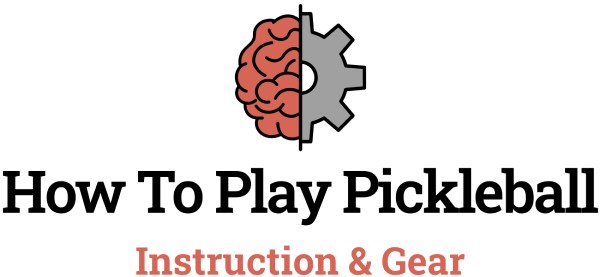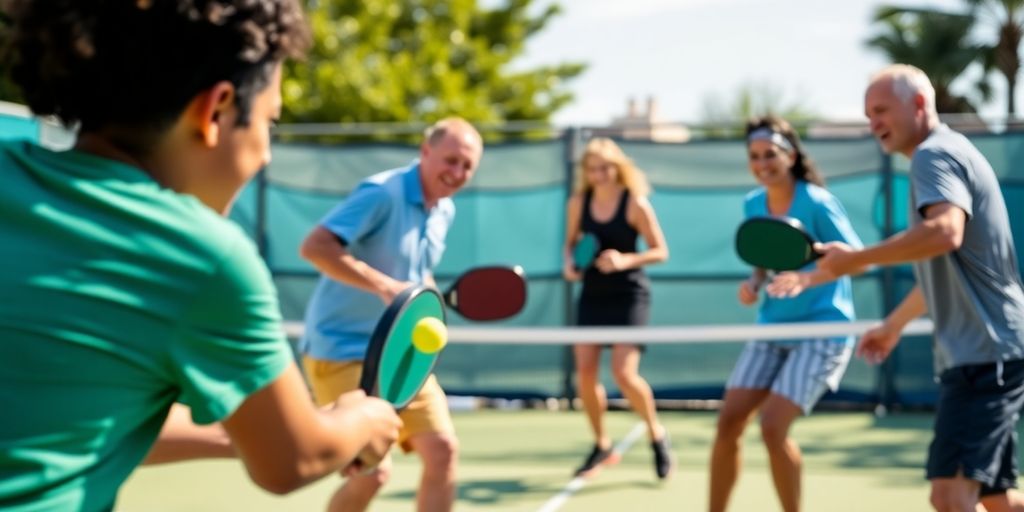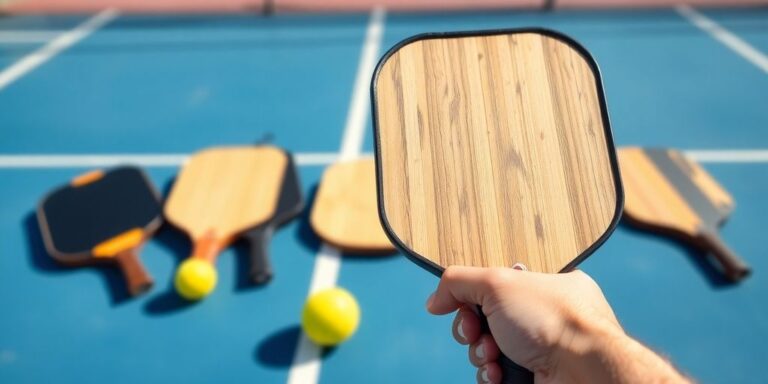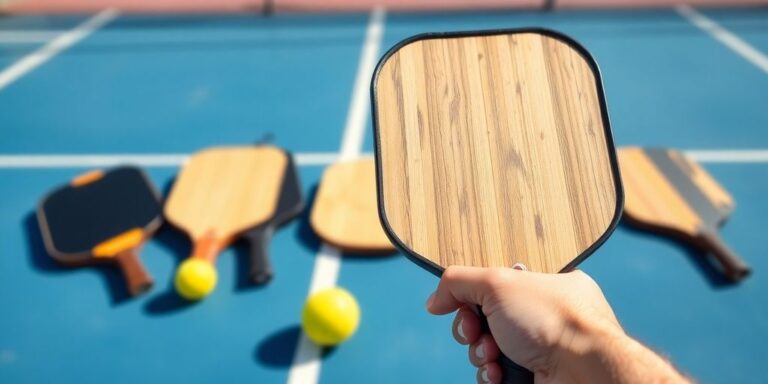Pickleball is growing fast, and with it, the need to understand skill ratings. If you’ve ever played, you might have heard players throwing around numbers like 3.5 or 4.0. But what do these numbers mean? Basically, they help players find matches at their level and track how they’re doing. This guide will break down the different levels of pickleball, from beginner to advanced, and explain the rating systems like UTPR and UTR-P. Whether you’re just starting or looking to climb the ranks, understanding these ratings can make your pickleball journey more fun and competitive.
Key Takeaways
- Pickleball ratings help match players of similar skill levels.
- Different systems like UTPR and UTR-P offer varied rating scales.
- Beginners are usually rated between 1.0 and 2.5.
- Advanced players score 4.0 and above.
- Improving your rating involves practice, coaching, and playing in tournaments.
Understanding Pickleball Skill Ratings
The Importance of Skill Ratings
Pickleball skill ratings are like a roadmap for players. They tell you where you stand and help you figure out your next steps. These ratings are crucial for fair and competitive play. They help match players with similar skills, ensuring everyone has a good time on the court. Plus, they let you track your progress and see how much you’ve improved over time. Whether you’re just starting or playing at a high level, knowing your rating can make the game more enjoyable and meaningful.
How Skill Ratings Are Determined
Skill ratings in pickleball are determined through a combination of self-assessment, peer assessment, and official evaluations during tournaments. Players usually start by rating themselves based on their understanding of the game and their ability to execute various shots. In official settings, ratings are often adjusted based on performance in matches. For instance, the pickleball skill levels range from 1.0 for beginners to 5.0 for advanced players, and each level represents specific competencies in gameplay.
Common Misconceptions About Ratings
There are several misconceptions about pickleball ratings that can lead to confusion. One common myth is that a higher rating automatically means you are a better player in every aspect, but that’s not always the case. Ratings are specific to the context of play and the type of opponents faced. Another misconception is that once you achieve a certain rating, it won’t change. In reality, ratings are dynamic and can fluctuate based on recent performances. Lastly, some players believe that these ratings are only for competitive play, but they are just as important for casual games to ensure fair matches and enjoyable experiences.
Exploring the Different Levels of Pickleball

Beginner Level Characteristics
Starting out in pickleball is all about getting a feel for the game. Beginners often find themselves learning the basics, like how to hold the paddle and understanding the two-bounce rule. These players usually fall in the 1.0 to 2.5 skill rating range. At this stage, you’re likely trying to hit simple shots and maybe even sustain a short rally. It’s a time for embracing mistakes and enjoying the learning curve.
- Learning the rules and basic strategies.
- Developing hand-eye coordination.
- Getting comfortable with the court layout.
Intermediate Level Skills
Once you’ve got the basics down, you move into the intermediate level. Here, the game gets a bit more strategic. Players start incorporating different shots and can sustain longer rallies. You’ll find yourself thinking more about positioning and how to outmaneuver your opponent. This level typically includes players with a 3.0 to 3.5 rating.
- Mixing up shot types.
- Using effective court positioning.
- Understanding and applying game strategies.
Advanced Level Strategies
At the advanced level, pickleball becomes a game of skill and tactics. Players are adept in all aspects of the game and use advanced strategies to gain the upper hand. These players, often rated 4.0 and above, have honed their skills through countless matches and practice sessions.
- Employing complex strategies and deceptive shots.
- Anticipating opponents’ moves.
- Excelling in competitive environments.
Pickleball is a journey from learning to mastering. Each level offers its own challenges and joys, making the sport engaging for everyone. Whether you’re just starting or have been playing for years, there’s always something new to learn and enjoy.
Understanding your skill level can enhance your performance on the court. If you’re curious about where you stand, consider exploring pickleball rating systems to get a clearer picture of your abilities.
Comparing UTPR and UTR-P Rating Systems
Overview of UTPR Ratings
The UTPR, or USA Pickleball Tournament Player Rating, is a well-established system used to evaluate players based on their performance in sanctioned tournaments. This rating system assigns players a four-digit score that is later simplified to a two-digit skill rating, ranging from 1.0 to 6.0+. Players often find this system reliable because it is based on actual match results. However, it tends to favor those who frequently participate in tournaments, which can be a downside for casual players who might see their skills improve but not reflected in their UTPR.
Understanding UTR-P Ratings
UTR-P, a newer system by Universal Tennis Rating, is set to replace the UTPR for USA Pickleball events by the end of 2024. This system offers a universal score from 1.0 to 10.0, unaffected by age, gender, or location. It’s designed to be inclusive, allowing both recreational and competitive players to obtain a rating. The process is straightforward: players can get a provisional rating quickly by signing up on the UTR-P platform and inputting their match history.
Key Differences Between UTPR and UTR-P
- Basis of Evaluation: UTPR relies heavily on tournament performance, while UTR-P can incorporate both competitive and recreational matches.
- Rating Scale: UTPR uses a 1.0 to 6.0+ scale, whereas UTR-P expands this to a broader 1.0 to 10.0 scale.
- Accessibility: UTR-P is more accessible to all players, offering free ratings and accepting provisional scores, which can be beneficial for those new to competitive play.
As the pickleball community grows, understanding these rating systems becomes crucial. Each system has its unique approach, with UTPR focusing on rigorous tournament play and UTR-P offering a more inclusive, broad-ranging evaluation.
For a deeper dive into how these systems compare with others like DUPR, you might want to check out discussions by experts such as Rob Nunnery and Adam Stone in their insightful podcast episodes.
Improving Your Pickleball Rating
Effective Practice Techniques
Improving your pickleball rating comes down to one main thing: practice. Playing regularly is key to getting better. To make the most out of your practice sessions, try these techniques:
- Drill Consistently: Focus on specific shots like dinks, volleys, and serves. Repetition helps build muscle memory.
- Practice with Purpose: Set goals for each session, whether it’s improving your backhand or mastering a new strategy.
- Play with Better Players: Challenge yourself by playing against those with higher skill levels. This pushes you to adapt and learn.
The Role of Coaching in Skill Development
Hiring a coach can be a game-changer. Coaches provide personalized feedback and help you refine your technique. They can identify weaknesses you might not notice and offer strategies to overcome them. Look for a coach who understands your goals and can tailor lessons to your needs. Group lessons are also a great way to learn in a supportive environment.
Participating in Tournaments
Tournaments are not just about competition—they’re a learning experience. Participating in tournaments allows you to test your skills under pressure, observe other players, and gain invaluable insights. Plus, it’s a great way to meet other enthusiasts and learn from their experiences.
"In the world of pickleball, every match is a chance to learn something new. Whether you win or lose, you gain experience that helps you grow as a player."
Overall, the journey to improving your pickleball rating is a mix of dedication, learning, and enjoying the game. Keep practicing, seek guidance when needed, and don’t shy away from competition. With time, you’ll see your skills and ratings soar.
Alternative Pickleball Rating Systems

Introduction to DUPR
The Dynamic Universal Pickleball Rating (DUPR) is a popular choice among players who want a comprehensive view of their skills. It’s a system that covers both doubles and singles play, offering a rating range from 2.0 to 8.0. DUPR evaluates your last 60 doubles matches or 30 singles matches over the past year. It factors in the competition level and match type, whether it’s a casual club game or a high-stakes tournament. This ensures players get a fair assessment of their abilities.
- Pros:
- Includes both sanctioned and non-sanctioned matches.
- Helps reduce ‘sandbagging’ by limiting self-ratings for tournament brackets.
- Offers a universal standard for player ratings.
- Cons:
- May not fully reflect the skills of those who don’t play in tournaments.
- The algorithm’s proprietary nature means players can’t predict how their actions impact their rating.
Global Pickleball Network (GPN)
The Global Pickleball Network (GPN) is another platform gaining traction. With over 120,000 registered players, GPN provides a rating system that ranges from 2.0 to 6.0. Players can enter results from leagues, tournaments, and practice matches, and the system offers separate ratings for singles and doubles. Once you join, you get a profile page showcasing your level, ranking, match history, and a chart tracking your progress. Interestingly, your GPN rating can integrate with your DUPR rating, making it a versatile tool for players.
Other Emerging Rating Platforms
Several other rating systems are emerging, though they are less common:
- World Pickleball Federation (WPF) Rating System: Similar to DUPR, used for international play, considering the best 12 results over the past year.
- International Pickleball Federation (IPF) Rating System: Aligns with USAPA’s system for international competition.
- Local Club or Regional Ratings: Some clubs have their own systems based on local league play, which might not translate well nationally or internationally but are useful for internal events.
Pickleball ratings are more than just numbers; they’re a way to ensure fair play and match players with similar skills. As you explore these systems, remember that each has its unique purpose and benefits. Whether you’re aiming for a higher rating or simply enjoying the game, understanding these systems can enhance your pickleball experience.
For those looking to take their game to the next level, advanced analytics platforms like PB Vision offer insights into performance, helping players refine their skills and potentially improve their ratings. Understanding these systems is crucial for anyone serious about competitive play, as emphasized in this guide.
The Impact of Ratings on Pickleball Competitions
How Ratings Affect Tournament Seeding
In pickleball tournaments, ratings are like the secret sauce that makes everything run smoothly. They determine who plays against whom, ensuring that matches are fair and competitive. Imagine stepping onto the court, only to face someone way out of your league. Not fun, right? Ratings help avoid these mismatches by seeding players according to their skill levels. This way, you get to enjoy matches that are challenging but not impossible.
Here’s how it typically works:
- Initial Seeding: Players are grouped based on their ratings.
- Match Progression: As the tournament progresses, players face others with similar performance outcomes.
- Finals and Awards: The top-rated players battle it out for the championship, often culminating in the most thrilling matches.
The Role of Ratings in League Play
In league play, ratings are the backbone of team formation and match scheduling. They ensure that teams are balanced, making the games engaging for everyone involved. Without ratings, leagues would struggle to maintain a level playing field, leading to frustration and potentially less participation. Leagues often use ratings to:
- Form Teams: Ensure teams have a mix of skill levels for balance.
- Schedule Matches: Pair teams with similar overall ratings to make games competitive.
- Track Progress: Monitor players’ improvements over the season.
Balancing Competition with Ratings
While ratings are crucial for organizing competitions, they can sometimes create pressure for players to maintain or improve their scores. It’s important to remember that ratings are just a tool to enhance the game, not the end-all-be-all of pickleball. Players should focus on enjoying the sport and improving their skills naturally.
Remember, the true spirit of pickleball lies in its community and the fun of the game, not just in the numbers on a scorecard. Ratings are there to help us enjoy the game more, not stress us out.
Self-Rating in Pickleball
How to Self-Assess Your Skills
Self-rating in pickleball is all about honesty. You look at your game and decide where you stand. The self-rating system lets you score yourself from 1.0 to 6.0 based on your skills. It’s a simple yet effective way to gauge your own abilities. Here’s how you can do it:
- Understand the Basics: Start by understanding the general skill levels. Beginners might just be learning the rules, while advanced players can execute complex strategies.
- Assess Your Skills: Evaluate your ability in key areas like serving, returning, and net play. Are you consistent with your shots? Can you maintain rallies?
- Be Honest: It’s tempting to rate yourself higher, but accuracy is key. An honest assessment helps you find the right playing partners and improve over time.
Benefits of Self-Rating
Self-rating offers several advantages:
- Personal Growth: Knowing your level helps you set realistic goals and track your progress.
- Better Matchups: Playing with others at your skill level makes games more fun and competitive.
- Self-Awareness: Understanding your strengths and weaknesses can guide your practice sessions.
Self-rating is like looking in a mirror. It shows you where you are and where you want to be. Embrace it as a tool for growth.
Challenges of Self-Rating
While self-rating is useful, it comes with its own set of challenges:
- Bias: It’s easy to overestimate your abilities. Try getting feedback from peers to ensure accuracy.
- Inconsistency: Your performance can vary day-to-day. Consider multiple sessions before finalizing your rating.
- Lack of Standardization: Different players might use different criteria, leading to inconsistent ratings.
In pickleball, your skill rating can range from 1.0 for beginners to 5.5+ for advanced players. Understanding these ratings is essential for fair competition and personal growth. So, take the time to assess yourself honestly and enjoy the game at your level.
When it comes to self-rating in pickleball, it’s important to be honest about your skills. This helps you find the right level of play and improve faster. If you’re looking for more tips and guidance, check out our website for exclusive content and resources!
Wrapping Up Our Pickleball Journey
So, there you have it, a deep dive into the world of pickleball ratings and rankings. Whether you’re just starting out or have been playing for a while, understanding where you stand can really make a difference. It helps you find the right matches and track how you’re improving over time. Remember, it’s not just about the numbers. It’s about having fun, meeting new people, and enjoying the game. So, keep playing, keep learning, and most importantly, keep having fun on the court. And who knows? Maybe one day you’ll find yourself moving up the ranks. Until then, enjoy every serve, volley, and rally!
Frequently Asked Questions
What exactly is a pickleball rating?
A pickleball rating is a number that shows how good you are at playing pickleball. It helps match you with players of similar skills for fun and fair games.
How can I find out my pickleball skill level?
You can take a quiz or use a skill assessment chart to rate yourself. If you play in official games, you might get an official rating.
What are UTPR and UTR-P ratings?
UTPR and UTR-P are two systems that rate pickleball players. UTPR is used for tournaments, while UTR-P is a newer system that also includes self-ratings.
What does a beginner rating in pickleball mean?
A beginner rating, usually between 1.0 and 2.5, is for new players who can hit basic shots and understand simple rules.
Why is knowing my pickleball rating important?
Knowing your rating helps you play against others with similar skills, making games more enjoyable and fair.
How can I improve my pickleball rating?
Practice a lot, play against better players, and maybe get some coaching to improve your skills and raise your rating.




